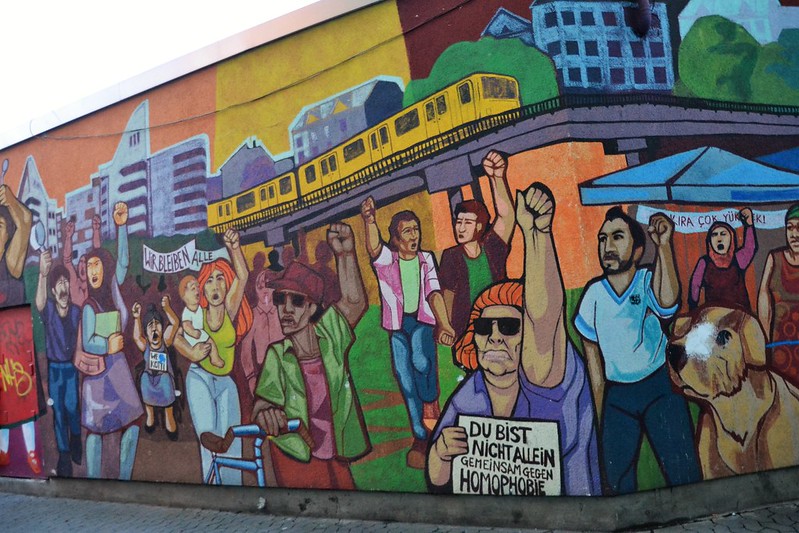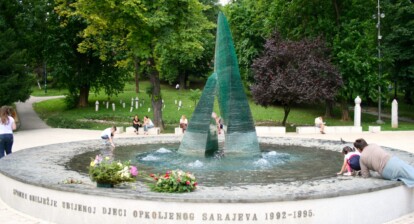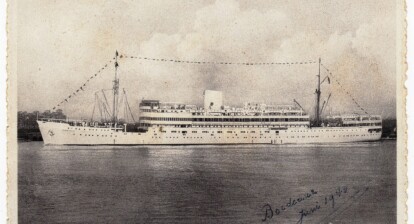Kreuzberg, Berlin: The vibrant district named after the highest natural hill in Berlin. The centre of squatter uprisings in the late 1970s. The poorest district in West Berlin in the 1980s. The home to Berlin’s punk rock movement. A place known for the 1st May riots and the Myfest. Characterised by diversity and contrasts. And finally, yet importantly – the district where the long-awaited meeting of the EUSTORY History Campus Editors’ team took place in 2022. While in Germany’s capital city, the team took the opportunity to stroll the streets of the multicultural Kreuzberg and ask locals and foreigners what makes the district special.
Romi and Rod, Chile/Germany

One of the green spaces at the river bank sides In Friedrichshain- Kreuzberg (Photo: Private)
Why did you decide to live in Kreuzberg?
Rod: We have the green areas of Viktoriapark and Tempelhofer Feld nearby. It’s the perfect situation for a dog and a kid.
Romi: Viktoriapark is a really nice place to hang out with your friends and family, but our favourite park is Tempelhofer Feld, which is almost bordering with Neukölln.
What do you think makes Kreuzberg unique?
Romi: There is a big mix of cultures everywhere in Berlin, but here in Kreuzberg, it’s special and we really wanted our son to have such an experience.
Rod: And also because we’re not German, we’re from Chile.
Is Kreuzberg a good place for young people?
Rod: For young people, it’s getting better and better, but crime rates in Kreuzberg and Neukölln are on the rise. We started seeing things we haven’t seen four years ago. There are many homeless people, and drug addicts and it’s difficult to witness things. But I guess it’s a part of every big city. It’s different from other parts of Berlin. There are different Kreuzbergs within Kreuzberg.
There are different Kreuzbergs within Kreuzberg – Rod from Chile
Alexandra and Claudia, Germany

The State Museum for Modern Art, Photography and Architecture (Berlinische Galerie,) located in Kreuzberg (Photo: Private)
Where are you from?
Alexandra: I’m from southwest Germany, but I’ve lived in Berlin for 3 years. I came here in search of work.
Claudia: I’ve lived in Berlin for 20 years now, in the southeast, not too far away [from Kreuzberg].
Why are you in Kreuzberg today?
Alexandra: We’re going to the State Museum for Modern Art, Photography and Architecture now; we don’t have a preference for Kreuzberg. I think it’s like every other zone, similar to the central part of Berlin.
Do you think Kreuzberg is diverse and culturally appealing?
Alexandra: For me, Kreuzberg is not that special, only for certain occasions like visiting a museum or going to a restaurant. There are so many appealing districts all over Berlin. The ones who consider it a symbol of diversity are mostly tourists. While it is true that it’s on the popular side, Berlin offers variety and diversity, and it’s tough to pick a place for which you can say “Yes, this is it.” Yes, it is appealing in a way, but so are other parts of Berlin.
Claudia: It’s not like an end in itself. Sometimes you come here to meet a friend, but it is not a place to walk around or even to move to. The same diversity is found all over Berlin.
The same diversity is found all over Berlin – Claudia from Germany
Reelika, Den and Annette, Estonia

Reelika, Den and Annette (Photo: Private)
Are you familiar with Kreuzberg?
Reelika: Not too much. We’re from Estonia.
Is this your first time in Berlin?
Reelika: It’s my third time and I love it! The first time I was with friends strolling around. The second time I took an architectural tour.
What do you think about the diversity here?
Den: Feels like it’s diverse.
Annette: For our country, it’s not that colourful, you can probably see similar landscape in the capital city of Estonia, Tallinn. We’re from there.
Den: To tell the difference between Tallinn and Berlin, just look at the streets. We enjoy the infrastructure. The bicycles. We’re struggling with this in Tallinn, so it’s good to see that it’s possible. I know that some friends in Estonia come here because they feel there is more tolerance and freedom.
I know that some friends in Estonia come here because they feel there is more tolerance and freedom. – Den from Estonia
Cecilia and Lisa, Sweden

Cecilia and Lisa (Photo: Private)
What brought you to Kreuzberg?
Cecilia: I’m here because I’m interested in the history [of Berlin], and my friend here knows a lot. It’s good to be here with a guide and to see it for real. We’re interested mostly in the “older” history, from the time of the Holocaust and the Second World War.
Lisa: What brought us to Kreuzberg was the Jewish Museum.
Would you find places similar to Kreuzberg in your city in Sweden?
Cecilia: We are from the south east part of Sweden – Östra Eastern Götaland. We’re from the countryside, so it’s quite different.
Can you compare the diversity of Stockholm with the cultural extravaganza of Berlin?
Cecilia: Berlin has a capital vibe, but it’s calmer and less stressful. Stockholm and Berlin are nice cities.
Lisa: But the history is still so “alive” here and so much has happened in Berlin. In Stockholm, a lot has happened and on top of that hundreds of years have passed. If you would have to see diversity in Stockholm, you would have to go to the suburbs.
Fee, Germany

Fee and her friend Gabby (Photo: Private)
Have you heard about the Festival Carnival of Cultures?
Fee: Yes, it takes place in May or June near Whitsunday (Pentecost Sunday,) and it is usually organized by Radio 1. This year it was cancelled due Covid-19.
Have you ever attended the festival?
Fee: Yes, of course! We live here. During the festival, we sat here in our street. But there was too much noise and there were too many people. It was chaotic several days before the festival. My husband and I are old now and it is an overload for us. When I came from work, I wanted to leave my car and I could not find a parking spot.
What do you think about the message of the festival (celebrating all forms of cultural expression, as well as supporting empowerment and identity)?
Fee: Principally the message is right! The people who dance and move around in brightly coloured costumes are not the problem. It is some young people who are so uncontrollable. They shout “fotze” from their scooters and lack respect. Speaking of manners, that is a real problem.
The opinions of the interviewees are as diverse as the array of cultural opportunities Kreuzberg offers. It is only natural – today, there are more than 180 nationalities living there, and the district attracts artists, foodies, museum and coffee lovers. Trendy, bohemian, quirky, hipster, eclectic, alternative and artsy are only 7 of the adjectives that local guides use to describe it. As far as the EUSTORY History Campus editors’ team in concerned, the district home to our 2022 meeting already has a special place in our hearts.





